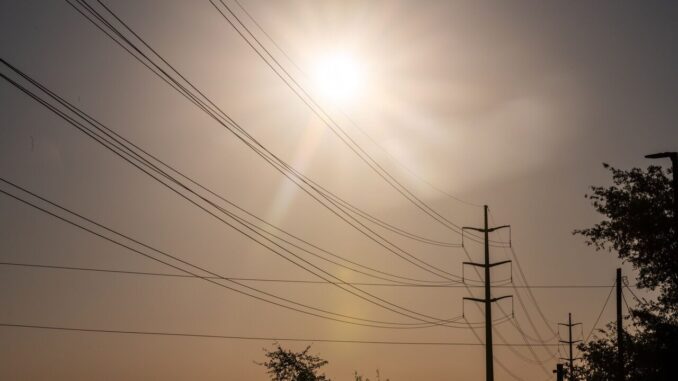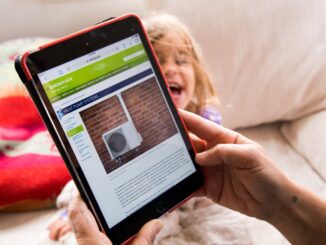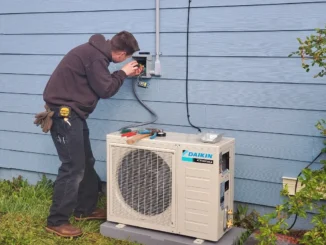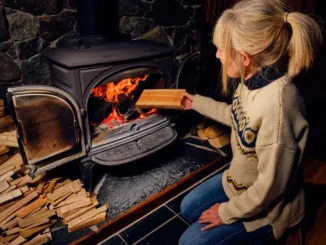Heat pump fans often point to the widespread use of the devices in cold nations such as Norway and Sweden as evidence they “work” in cold weather, but they fail to mention that many Scandinavian households have more than one heat pump or use an additional form of heating, typically a wood-burning stove. Gathering wood for heating is common across the Nordic countries. More modern models claim to “work well” at low temperatures, but they will still lose efficiency as it gets colder.
The economics of heat pumps vary greatly across the US, depending on the amount of heat needed and the price of natural gas. The installation of heat pumps is expensive, with air source heat pumps costing between $2,500 and $10,000, with the average homeowner spending $5,500. However these costs can jump to up to $30,000 in homes which don’t have existing ductwork. Ground source (or geothermal) heat pumps work much better in cold weather but they are much more expensive. They also require a lot of land so aren’t suitable for many homes.
There are tax credits in the Inflation Reduction Act that cover 30 percent of the upfront costs of buying and installing a heat pump, up to $2,000. For households with less than 80 percent of the median area income, the subsidy is higher and will cover 100 percent of the upfront costs, up to $8,000. Many states also offer rebates.
According to the International Energy Agency, heat pumps can reduce American heating bills by up to $300 per year. That’s a significant saving for those households whose installation costs are fully covered by the government, but not so great for those left funding thousands of dollars of upfront costs. People using natural gas for heating see smaller benefits since gas is pretty cheap in the US.
So are heat pumps hot or not? The boring answer to that is “it depends”. Low income households with older electrical resistance or propane heaters are likely to benefit the most from getting a heat pump as they will have most if not all of the upfront costs covered and will make significant savings on energy bills. These households are also less likely to have air conditioning, so the installation of a heat pump will give them a new capability for cooling.





There are four main ways in which the roughly 131 million American homes are heated: electricity, natural gas, propane or fuel oil. The vast majority use electricity or natural gas. While some 20 million homes already have a heat pump, a similar number still rely on inefficient electric resistance heaters which are expensive to use, and predominantly found in low and middle-income households.
Around half of US homes are heated with gas – mostly natural gas, although some 10 million homes use propane or heating oil which is stored in tanks on the property, and powers often aging furnaces. These furnaces heat up air which is then blown round the homes though ducts and vents. The use of hot water pipes and radiators, as normally seen in the UK, is comparatively unusual.
The other big difference from the UK is that around 90 percent of homes use some form of air conditioning. Two-thirds of households use central air conditioning or a central heat pump as their main AC equipment. That means that quite a lot of US homes either don’t have air conditioning, use portable AC or have a system that is powered by gas.
Against this backdrop the US Government plans to install 20 million heat pumps by 2030, with 40 percent of the benefits being directed to disadvantaged communities. Lawmakers hope that as existing heating and air conditioning systems break down with age they will be replaced by modern heat pumps.
Heat pumps run on electricity, and are hailed as key to achieving zero carbon goals by removing the use of fossil fuels for heating. Of course, that assumes that the electricity that powers the heat pumps is generated from something other than fossil fuels – unfortunately, around 60 percent of electricity in the US comes from fossil fuels.
There are other challenges with heat pumps, in particular their performance in cold weather, when their operations become less efficient. This is a fundamental feature of air-source heat pumps since they involve indoor and outdoor components – when it’s cold outside the outdoor component must be heated in order to work properly, and this means less energy is available for heating indoors. The lower temperatures fall, the worse this effect becomes, and the more expensive the system becomes to run.
Heat pump fans often point to the widespread use of the devices in cold nations such as Norway and Sweden as evidence they “work” in cold weather, but they fail to mention that many Scandinavian households have more than one heat pump or use an additional form of heating, typically a wood-burning stove. Gathering wood for heating is common across the Nordic countries. More modern models claim to “work well” at low temperatures, but they will still lose efficiency as it gets colder.
The economics of heat pumps vary greatly across the US, depending on the amount of heat needed and the price of natural gas. The installation of heat pumps is expensive, with air source heat pumps costing between $2,500 and $10,000, with the average homeowner spending $5,500. However these costs can jump to up to $30,000 in homes which don’t have existing ductwork. Ground source (or geothermal) heat pumps work much better in cold weather but they are much more expensive. They also require a lot of land so aren’t suitable for many homes.
There are tax credits in the Inflation Reduction Act that cover 30 percent of the upfront costs of buying and installing a heat pump, up to $2,000. For households with less than 80 percent of the median area income, the subsidy is higher and will cover 100 percent of the upfront costs, up to $8,000. Many states also offer rebates.
According to the International Energy Agency, heat pumps can reduce American heating bills by up to $300 per year. That’s a significant saving for those households whose installation costs are fully covered by the government, but not so great for those left funding thousands of dollars of upfront costs. People using natural gas for heating see smaller benefits since gas is pretty cheap in the US.
So are heat pumps hot or not? The boring answer to that is “it depends”. Low income households with older electrical resistance or propane heaters are likely to benefit the most from getting a heat pump as they will have most if not all of the upfront costs covered and will make significant savings on energy bills. These households are also less likely to have air conditioning, so the installation of a heat pump will give them a new capability for cooling.
However in colder states heat pumps could need a secondary heating source which might be difficult to afford. For higher income households the economic benefits are less clear. They will have to pay higher upfront costs which will take years to recover through lower bills. If they currently have gas heating the savings will be smaller and the capital costs take longer to repay.
The climate benefits in the short term will be marginal since the US still relies heavily on fossil fuels for electricity generation. Switching from burning gas in the home to burning gas in power stations does reduce emissions since power stations are more efficient. However electricity demand will increase, as people switch from gas to electric heating, and will rise further if the homes which don’t currently have electric air conditioning begin to use their heat pumps for cooling.
Bringing cooling to houses that don’t currently have air conditioning will be an absolute increase in energy demand, rather than a change from one form of energy to another, and it could be big. Air conditioners are the domestic appliances that generally consume the most electricity, accounting for an average of 17 percent of total US household electricity usage (compared with 15 percent for space heaters).
This higher electricity demand will strain America’s creaking power grids, which already struggle with reliability issues, and they will increase the need for more generation and grid infrastructure such as power lines and transformers, adding to the multi-billion dollar bill for electricity system upgrades. To make heat pumps really work we need reliable low carbon electricity and plenty of it otherwise there is a risk the increased demand will cause more blackouts. And if you have electric heating, a blackout means no heating either.
There are a lot of numbers in this article. And they add up to one conclusion: it’s hard to be more than lukewarm on heat pumps. They will be great for people who get them for free to replace old, expensive and inefficient heating systems – these people will also be getting free air conditioners. They will be a lot less great for everyone else, involving high upfront costs, and more grid infrastructure that will be paid for through higher bills and taxes. And as long as the majority of electricity comes from fossil fuels, their climate benefits will be marginal.